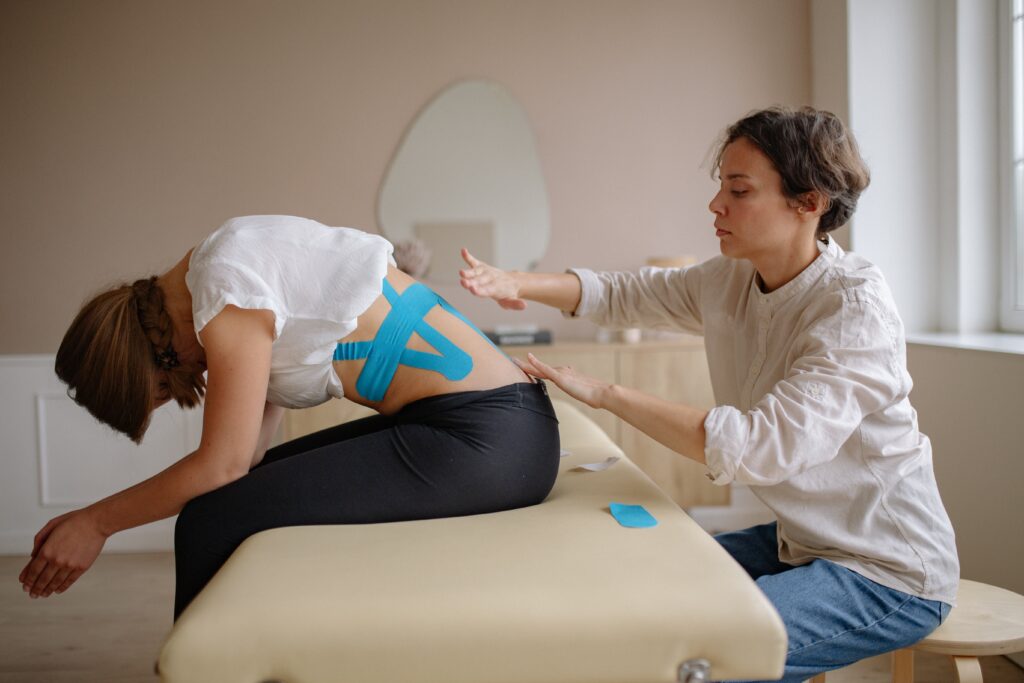Introduction Of Back Pain Physiotherapy at Home
Dealing with back pain can be challenging, but the good news is that effective physiotherapy can be done at home. Enter the innovative concept of “Back Pain Physiotherapy At Home,” In this comprehensive guide, we explore various strategies, exercises, and expert insights to help you manage and alleviate back pain without leaving the comfort of your home.
In the pursuit of well-being, back pain stands as a pervasive challenge for many individuals, impacting daily activities and diminishing overall quality of life. The quest for relief often leads people to explore various solutions, with physiotherapy emerging as a promising avenue.

However, the accessibility and convenience of traditional clinic-based physiotherapy may pose constraints for some. Enter the innovative concept of “Back Pain Physiotherapy At Home,” a tailored approach designed to bring the benefits of therapeutic intervention directly to the individual’s living space.
This evolving paradigm recognizes the importance of addressing back pain not only as a symptom but as a dynamic interplay of various factors. At-home physiotherapy offers a personalized and proactive solution, enabling individuals to actively participate in their rehabilitation journey.
This introduction will explore the principles, advantages, and practical aspects of at-home physiotherapy for back pain, highlighting how this approach empowers individuals to take charge of their recovery while fostering a holistic understanding of spinal health. As we delve into the realm of self-care and targeted exercises, the goal is to unveil the transformative potential of bringing professional physiotherapy into the comfort of one’s home.
Understanding Back Pain Physiotherapy at Home
Back pain is a common issue that affects millions worldwide. It can result from various factors, including poor posture, muscle strain, or underlying medical conditions. Before diving into physiotherapy techniques, it’s crucial to understand the root causes of back pain Physiotherapy at home.
Back pain can be categorized into two main types: acute and chronic. Acute back pain typically lasts for a short duration and is often caused by injury or muscle strain. Chronic back pain persists for an extended period, often three months or more, and may be associated with underlying health conditions.
Common Causes of Back Pain Physiotherapy at Home
Explore the primary reasons behind back pain, such as sedentary lifestyles, muscle imbalances, and spinal conditions.
Impact of Lifestyle on Back Health
Learn how daily habits and lifestyle choices can contribute to or alleviate back pain.
Importance of Physiotherapy at Home

Physiotherapy is a proven method to manage and prevent back pain. Discover why home-based physiotherapy is a convenient and effective solution.
Advantages of Home-Based Physiotherapy
Explore the benefits of performing physiotherapy exercises in the comfort of your home. Getting Started with Back Pain Physiotherapy at Home
Now that we understand the importance, let’s delve into practical steps to start your home-based physiotherapy journey.
Setting Up Your Home Physio Space
Create a dedicated space at home for your physiotherapy exercises, ensuring a comfortable and safe environment.
Essential Equipment for Home Physio
Explore the minimal equipment required for effective home-based physiotherapy.
Physiotherapy Exercises for Back Pain Relief
Here, we provide a curated list of exercises specifically designed to target and alleviate back pain Physiotherapy at home.
Stretching Exercises
Learn simple yet effective stretching exercises to improve flexibility and reduce muscle tension.
Strengthening Exercises
Discover exercises focused on strengthening core muscles to provide better support to your spine.
Posture Correction Techniques
Explore techniques to correct poor posture, a common contributor to back pain.
Back Pain Physiotherapy at Home: Personal Experiences

Real-life stories and experiences from individuals who successfully managed back pain through home-based physiotherapy.
Yes, but always inform your healthcare provider to ensure compatibility with other treatments.
The Power of Consistency in Back Pain Relief
Consistency is the cornerstone of any successful physiotherapy routine. By incorporating these exercises into your daily or weekly schedule, you can gradually build strength and flexibility. Remember, the key to long-term relief lies in making these exercises a part of your lifestyle.
External Link: Exploring Advanced Back Pain Physio Techniques
For those seeking additional insights and advanced techniques, check out this resource on advanced back pain physiotherapy at home. It provides a deeper dive into specialized exercises and strategies for a more tailored approach to back pain management.
A Positive Outlook on the Road to Recovery
Maintaining a positive mindset is essential on the journey to recovery. While back pain can be challenging, viewing physiotherapy as a proactive step towards improvement fosters optimism. Embrace the process, celebrate small victories, and acknowledge that each exercise brings you closer to a pain-free life.
Embracing a Pain-Free Lifestyle
In conclusion, the journey towards a pain-free life through home-based physiotherapy is both empowering and achievable. By following the outlined exercises, maintaining consistency, and seeking professional guidance when needed, you are taking proactive steps towards a healthier and happier life.
Celebrating Small Victories
Acknowledging progress, no matter how small, is crucial on your journey to relief. Whether you achieve improved flexibility, less discomfort, or better posture, celebrate these victories. Recognizing and appreciating these milestones boosts morale and motivates you to continue your physiotherapy routine.
Incorporating Back Pain Physiotherapy at Home into Daily Life
Integrating physiotherapy seamlessly into your daily routine enhances its effectiveness. Simple adjustments like incorporating stretches during work breaks or maintaining good posture while sitting can contribute significantly to overall back health.
Expert Tips for Maximum Impact
Experts recommend starting with gentle exercises and gradually increasing intensity. Listen to your body, and if any exercise causes persistent discomfort, consult with a healthcare professional. Additionally, ensure a balanced approach by combining stretching, strengthening, and posture correction exercises.
Harnessing the Power of Posture
Proper posture is a linchpin in preventing and managing back pain. Learn practical tips for maintaining good posture in various activities, from sitting at a desk to lifting heavy objects. Small adjustments can yield significant improvements in spinal health.
The Role of Nutrition in Back Pain Physiotherapy at Home Management
A holistic approach to back pain includes considering nutritional factors. Certain foods possess anti-inflammatory properties and can support overall musculoskeletal health. Incorporating a balanced diet with adequate nutrients contributes to the success of your physiotherapy journey.
External Link: Understanding the Anatomy of Back Pain
For those curious about the intricate details of back pain anatomy, this resource provides a deeper understanding. Exploring the physiological aspects of back pain enhances awareness and aids in tailoring your physiotherapy routine.
Overcoming Challenges in Home-Based Physiotherapy

While home-based physiotherapy offers convenience, challenges may arise. Address common obstacles like lack of motivation or distractions to ensure a consistent and effective routine.
Holistic Wellness: Mind-Body Connection
Recognizing the interconnectedness of physical and mental well-being is paramount. Techniques such as mindfulness and relaxation exercises complement physiotherapy, fostering a harmonious mind-body relationship.
Leveraging Technology for Home Physio
Explore innovative apps and online resources designed to guide and track your home-based physiotherapy progress. Technology can be a valuable ally in ensuring proper form and consistency.
In the realm of home physiotherapy, leveraging technology has become a game-changer, enhancing accessibility and effectiveness. Telehealth platforms have empowered individuals to connect with physiotherapists remotely, enabling personalized consultations from the comfort of home.
Video conferencing and virtual sessions not only facilitate real-time guidance but also allow professionals to visually assess movements, ensuring tailored exercises that align with the individual’s specific needs.
Moreover, mobile applications have emerged as valuable tools for home physiotherapy. These apps often come equipped with curated exercise programs, progress-tracking features, and interactive tutorials. Users can access a wealth of resources at their fingertips, promoting consistency and engagement in their rehabilitation journey.
The integration of wearable devices, such as fitness trackers or smartwatches, further augments the tech-savvy approach by providing real-time data on movement patterns and activity levels, enabling both individuals and physiotherapists to monitor progress and make informed adjustments to the home-based physiotherapy plan.
Elevating Your Home Physiotherapy Routine
Elevate your routine with advanced exercises as you progress. Consult with a physiotherapist for personalized recommendations to address specific concerns and optimize your back pain management.
Building a Support System
Share your journey with friends or family to build a supportive environment. Having a reliable support system can provide motivation, encouragement, and accountability.
Tracking Progress: A Visual Journey
Document your physiotherapy journey visually. Take photos or keep a journal to track improvements. A visual record serves as a powerful motivator and a testament to your dedication.
Empowering Others Through Your Experience
As you experience the benefits of home-based physiotherapy, consider sharing your story. Your experience can inspire others to embark on their journey towards a pain-free life.
Enduring the challenges of back pain can be a transformative journey, one that not only shapes personal resilience but also offers an opportunity to empower others facing similar struggles. Sharing your experience with back pain can be a source of inspiration and guidance.
Conclusion
Embarking on a journey to alleviate back pain through home-based physiotherapy is a proactive step toward a healthier, pain-free life. Remember, consistency is key, and consulting with a healthcare professional is recommended for personalized guidance.
In conclusion, engaging in physiotherapy at home for back pain offers a practical and effective approach to alleviating discomfort and promoting long-term spinal health. By incorporating targeted exercises, stretches, and lifestyle adjustments, individuals can actively participate in their own well-being.
The convenience of at-home physiotherapy not only facilitates consistent adherence to prescribed routines but also empowers individuals to take control of their recovery process. Moreover, this approach encourages a holistic understanding of back pain, addressing not only symptoms but also underlying causes.
As a result, the tailored nature of home-based physiotherapy enables personalized care that can contribute to improved mobility, enhanced strength, and ultimately a better quality of life. Embracing these practices fosters a proactive approach to back pain management, promoting overall health and resilience for the long term.
FAQs Of Back Pain Physiotherapy at Home:-
What is Back Pain Physiotherapy at Home?
Back Pain Physiotherapy at Home is a personalized approach to addressing back pain through therapeutic exercises, stretches, and lifestyle adjustments conducted in the comfort of one’s home. It empowers individuals to actively participate in their recovery process.
How does it differ from traditional physiotherapy at a clinic?
While traditional physiotherapy often requires visits to a clinic, Back Pain Physiotherapy at Home eliminates the need for commuting. It provides convenience, allowing individuals to perform prescribed exercises and routines in their familiar surroundings.
Who can benefit from Back Pain Physiotherapy at Home?
Anyone experiencing back pain, whether chronic or acute, can benefit from at-home physiotherapy. It caters to a wide range of individuals, from those with mild discomfort to those undergoing post-surgery rehabilitation.
Are professional physiotherapists involved in the at-home sessions?
Yes, professional physiotherapists design personalized programs tailored to the individual’s condition. Telehealth consultations, instructional videos, and written guides are common methods of delivering guidance and support.
What exercises are typically included in at-home physiotherapy for back pain?
Exercises vary based on the specific condition, but they often include stretches, strengthening exercises, and mobility drills. Core exercises to enhance stability and flexibility are commonly incorporated.
Is at-home physiotherapy effective for all types of back pain?
While results may vary, at-home physiotherapy has shown effectiveness for various types of back pain, including muscle strains, herniated discs, and general discomfort. It is crucial to follow the prescribed program consistently.
Can at-home physiotherapy replace traditional clinic-based sessions entirely?
In some cases, at-home physiotherapy may suffice, but the severity of the condition and the need for hands-on assessment may require occasional clinic visits. The approach is often complementary to traditional physiotherapy.
How long does it take to see results with at-home physiotherapy?
Results vary based on the individual’s condition, adherence to the prescribed routine, and the severity of the back pain. Consistency and commitment play a crucial role in achieving positive outcomes.
Is at-home physiotherapy suitable for post-surgery rehabilitation?
Yes, at-home physiotherapy can be tailored to support post-surgery recovery. However, it is essential to follow the guidance of healthcare professionals and only engage in activities approved by the surgeon or physiotherapist.
Are there any age restrictions for at-home physiotherapy?
At-home physiotherapy is generally suitable for individuals of all ages. Programs can be adjusted to accommodate the specific needs and capabilities of different age groups, from young adults to seniors.
Remember, it’s crucial to consult with a healthcare professional before starting any new exercise program, especially for those with pre-existing medical conditions or concerns about their back pain.
Dr. Priyanka Bharadwaj (Physiotherapist)
Introducing CB Home Physiotherapist: Meet Dr. Priyanka Bharadwaj, a highly skilled female physical therapy expert based in Khanpur, Delhi. She brings her expertise right to your doorstep, offering personalized physiotherapy services in Khanpur and nearby areas.
With a solid background in home physiotherapy, Dr. Priyanka specializes in treating a wide range of conditions, including back pain, neck pain, knee pain, sciatica, and more. She’s also adept at post-surgery rehabilitation, helping patients recover from procedures like shoulder, knee, and hip replacements.
In addition to her two years of experience in hospitals and clinics, Dr. Priyanka has honed her skills in various specialties such as pediatric, geriatric, neurological, and musculoskeletal physiotherapy. Whether it’s helping children regain mobility or assisting seniors with balance issues, she’s dedicated to improving her patients’ quality of life.
Dr. Priyanka holds a Bachelor’s degree in Physiotherapy from the Manav Rachna International Institute of Research and Studies. Her compassionate approach and commitment to patient well-being make her a trusted choice for anyone seeking expert physiotherapy care in the comfort of their own home.


